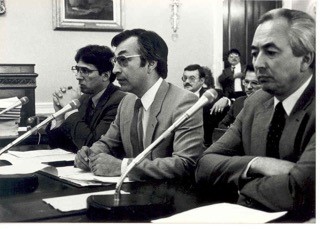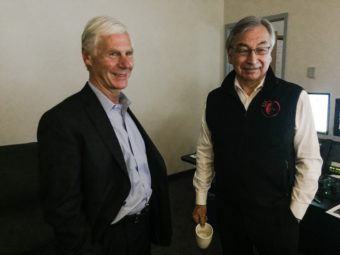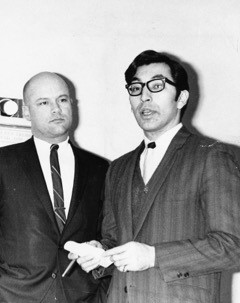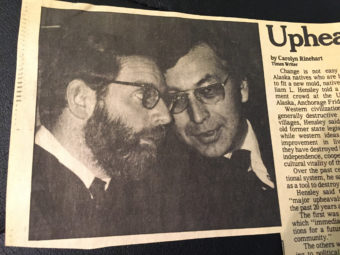
One afternoon in the mid-1970s, journalist John McPhee and an influential Alaska Native politician Willie Hensley took off from Anchorage in a de Havilland Otter and flew deep into the Alaska range, looking for a new state capitol.
Later, in his book “Coming into the Country,” McPhee introduced the rest of the nation to one of the most prominent, young Alaska Native leaders in the state. Hensley was instrumental in forcing the state and the federal government to settle land claims with its 60,000 Alaska Native residents.
William Hensley has a long memory. Dates, names, places, votes: History just seems to spill out of him. In his Anchorage garage, stacks of old framed photos, posters and political paraphernalia lean against a set of shelves.

On a recent Wednesday, he lifted one out from his first term in the state legislature. He was 25 years old.
“Let’s see, Mike Bradner is here somewhere. Here’s Don Young. We sat next to each other,” Hensley said.
The list goes on.
“There’s Mike Bradner over there, he’s still around. Tom Fink, who was the mayor of Anchorage, he’s still around, still alive,” he said.
Alaska’s modern history is very short. And, among the people who helped to shape the state, Hensley stands out.
From a semi-nomadic, traditional subsistence Inupiaq childhood to lobbying in the halls of Washington, D.C., Hensley straddled the enormous divide between rural and urban Alaska.
He was instrumental in lobbying for the Alaska Native Claims Settlement Act: A deal that journalist John McPhee in his book calls more significant than the statehood act. It changed the status and the structure of native societies in the state and paved the way for the Trans-Alaska Pipeline.
But Hensley didn’t start, or stop there.
He was born William Iggiagruk Hensley in 1941 in Kotzebue. Iggiagruk is his grandfather’s name.
“That G with a dot is a guh, not a g. Like my name Iggiagruk, the g with two dots. Oddly enough, in our language, iggiak is your throat. Iggik, is a mountain. Iggiagruk, is a small mountain. That’s my name,” he said.
At 15, Hensley was flown to a boarding school in pre-Civil Rights Era Tennessee. Before long, he was in college in Fairbanks and then George Washington University in the District of Columbia.
When he was 25, he was elected to the Alaska House of Representatives. He wasn’t the first Alaska Native lawmaker, but one of just a handful and definitely the youngest.

In 1974, Alaskans voted to move the state capitol out of Juneau, and the Lieutenant Governor asked Hensley to head the Capital Site Selection Committee.
The nine-member committee flew all over Alaska, trying to find a hundred square miles of land, near a mass transit artery, on state land, or cheap-for-the-state land, and far enough away from Anchorage and Fairbanks to satisfy voters.
It was a committee assignment Hensley says no politician in their right mind would accept. But he did, though he had some reservations.
“You know, we were basically a failing state until we got that first $900 million dollars in 1969. And we still had tons and tons of things that needed to be built: housing, schools, water and sewers, you know ports, airports. All these things that communities needed and I just didn’t think spending several billion dollars for a new capitol was the right thing to do,” he said.
That’s when Hensley met John McPhee, whom he had never heard of. And, he assumed McPhee needed a history lesson.
“I was trying to help. You know, I’ve sort of always felt this need to try to explain Alaska to people who didn’t know anything,” Hensley said. “And, I sort of felt the same way about him, so I was going on and on.”
And Hensley, who often can’t resist arching his eyebrows and dropping a dad-joke or two — couldn’t resist poking fun at the process to McPhee.
“For instance, we were flying along and there was this little creek down below, we had maps and stuff you know and it was called, Bulchitna,” he said. “And I said ‘huh, that’s a beautiful name for a new Capital. Bullchitna.”
Early on, Hensley said he had written McPhee off as just another white guy.
“I just knew back then that there were very few people that were non-native that had any concept of what our lives were out there. Also, who had just a limited comprehension of the space that our people had occupied for literally thousands of years,” he said.
So, what did Hensley think of McPhee’s book?
“Oh I kind of enjoyed the book actually. His was an honest portrayal, I think, and so that’s why I liked it,” he said.
“Coming into the Country” gave outsiders a glimpse into the rapidly changing landscape of Alaska Native leadership and society. When the state was split into twelve regions, each with its own native corporation, they had to split a billion dollars and 40 million acres of land. They were suddenly and collectively rich.
In the book McPhee borrows the term “Brooks Brothers native.” He uses it to describe a class of native person who has seen a much wider segment of the world than their forebearers and most of their contemporaries. He describes Alaska Airlines jets half-full of natives zipping around the state on business, investing in each other’s regions, building corporate empires.

And Hensley says, that was accurate.
“Yeah, there’s lots of stories about individuals who all the sudden started carrying around briefcases,” Hensley said. “That was not our world, right. And sometimes all they had was smoked salmon in there and maybe a sandwich, you know.”
Hensley retired in 2008. He says he’s left politics behind. Now, he’s focused on connecting Alaska’s native people to their culture. And, teaching. He says every generation worries if the next one has what it takes to point the state in the right direction. And he thinks the lessons of the past — his past — may offer some clues.
